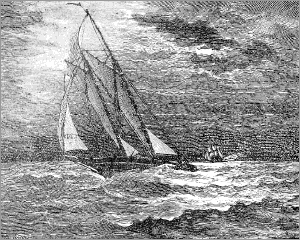| Home > Floripedia > Civil War, Scarcity of Commodities | |
Civil War, Scarcity of Commodities
A History of Florida1904
Scarcity of Commodities. Early in the war all Florida ports were blockaded, as, indeed, were all Southern ports. Sometimes vessels would make their way into port without being captured by the blockading vessels. Only in this way could goods be brought into the country. On account of the difficulty and danger of getting these goods, they were very costly, and many articles could not be procured for any price. During the last year of the war, coarse flannel cost $25 a yard, calico $10, and a spool of cotton thread, $2 for 93. Sixty dollars was considered a reasonable price for a pound of tea, and coffee was cheap at $40 a pound.

Blockade RunnersWhy were goods very expensive in the South during the war?
But coffee, tea, white sugar, and flour were luxuries, hard to get at any price, and not to be thought of for everyday use. Parched sweet potatoes or rye was used as a substitute for coffee, with sometimes a few grains of the real article added to give flavor. The people from Georgia would sometimes bring flour into Florida and exchange it for salt and salted fish. Although the government salt works on the coast had been broken up by Federal gunboats, there were still sheltered bays where salt could be procured.

Pine Forest in FloridaGive some illustrations of the prices prevailing. What was a substitute for coffee and how was flour secured?
On the undisturbed plantations of middle Florida, the necessaries of life were produced. There was corn and rice, sugar and syrup, cured and fresh meat. Farther South the pine forests yielded valuable products, and there were vast herds of cattle. These supplies were valuable not only in Florida, but to the Confederacy.
Much cotton had accumulated on the plantations, for it could not be sold. Spinning wheels and looms were busy, and people were glad enough to have garments of that strong homespun cloth that was woven. Hats were made of palmetto and corn "shucks," and shoes were made by the plantation shoemakers of home-tanned leather. Everybody used homemade soap, homemade candles, and even homemade ink.
Source:
Excerpt from Part Two, Chapter 15, "Natural Bridge" A History of Florida, 1904. Next Section; Table of Contents.
| Home > Floripedia > Civil War, Scarcity of Commodities |
Exploring
Florida: A Social Studies Resource for Students and Teachers
Produced by the Florida Center for Instructional
Technology,
College of Education, University of South Florida © 2005.